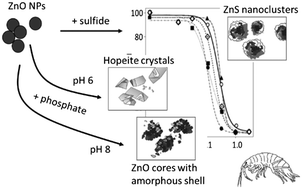Enhanced toxicity of environmentally transformed ZnO nanoparticles relative to Zn ions in the epibenthic amphipod Hyalella azteca†
Abstract
After release into the aquatic environment, engineered nanomaterials (ENMs) undergo complex chemical and physical transformations that alter their environmental fate and toxicity to aquatic organisms. Hyalella azteca are sediment-dwelling amphipods predicted to have a high exposure level to ENMs and have previously shown to be highly sensitive to ZnO nanoparticles (NPs). To investigate the impacts of environmentally transformed ZnO NPs and determine the route of uptake for these particles, we exposed H. azteca to ZnSO4, ZnO NPs, and environmental aged ZnO NPs which resulted in three types of particles: 30 nm ZnO–Zn3(PO4)2 core–shell structures (p8-ZnO NPs), micron scale hopeite-like phase Zn3(PO4)2·4H2O (p6-ZnO NPs), and ZnS nano-clusters (s-ZnO NPs). Treatments included freshwater, saltwater (3 ppt), and the presence of sediment, with a final treatment where animals were contained within mesh baskets to prevent burrowing in the sediment. Dissolution was close to 100% for the pristine ZnO NPs and phosphate transformed NPs, while s-ZnO NPs resulted in only 20% dissolution in the water only exposures. In the freshwater exposure, the pristine and phosphate transformed ZnO NPs were more toxic (LC50 values 0.11–0.18 mg L−1) than ZnSO4 (LC50 = 0.26 mg L−1) and the s-ZnO NPs (LC50 = 0.29 mg L−1). Saltwater treatments reduced the toxicity of ZnSO4 and all the ZnO NPs. In the presence of sediment, water column concentrations of Zn were reduced to 10% nominal concentrations and toxicity in the sediment with basket treatment was similarly reduced by a factor of 10. Toxicity was further reduced in the sediment only treatments where the sediments appeared to provide a refuge for H. azteca. In addition, particle specific differences in toxicity were less apparent in the presence of sediment. Bioaccumulation was similar across the different Zn exposures, but decreased with reduced toxicity in the saltwater and sediment treatments. Overall, the results suggest that H. azteca is exposed to ZnO NPs through the water column and NP transformations in the presence of phosphate do not reduce their toxicity. Sulfidized ZnO NPs have reduced toxicity, but their similar level of bioaccumulation in H. azteca suggests that trophic transfer of these particles will occur.



 Please wait while we load your content...
Please wait while we load your content...
